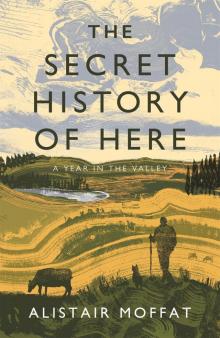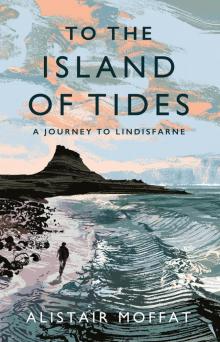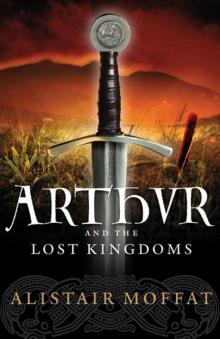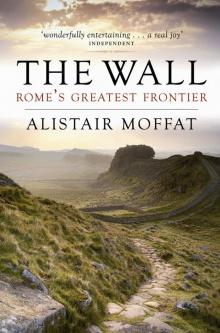- Home
- Alistair Moffat
Britain’s Last Frontier Page 7
Britain’s Last Frontier Read online
Page 7
The Sculptor’s Cave is so called because of a series of symbols carved on the walls near the entrances. Only one can be read as a naturalistic representation – what looks like a fish with fins and a tail. Even the descriptions of the others are obscure – a triple vesica, a pentacle, a crescent and v-rod, a step and a mirror case. But they are not unique. All of them and several others form part of a mysterious visual vocabulary that appears on more than 350 symbol stones carved by a people known to history as the Picts. Some of these are monumental – one standing near Covesea is 6.5 metres high – and they are also intricate, sometimes stunning works of art, while others are clearly more primitive. The earliest stones were set up at the beginning of the 5th century AD, at the end of the life of the cave shrine at Covesea. Clearly its sanctity had endured and it remained a place to be revered by the Picts.
The name first comes on record in AD 296, when Roman commentators reported that Pictish war bands had broken through Hadrian’s Wall and raided as far south as the city of Chester. Sounding very much like a soldiers’ nickname for an unfamiliar enemy, the first Picts or the Painted Warriors may not have originated in the north of Scotland, may not have been Picts at all. Their habit of wearing warpaint – almost certainly tattoos – may have seemed unusual, perhaps even quaint to the garrison of Hadrian’s Wall, something no longer done in the south, something they had not seen before and what prompted the Latin tag. In any event, the name stuck and, over the 4th and 5th centuries, the Picts became a feared and far-ranging threat to the province of Britannia. After a raid that reached London, they were described as transmarini and, while this is an obvious reference to their ability to attack from the sea, it may also mean that the Romans realised that they originated from Scotland Beyond the Sea, north of the Forth, the warriors who crossed the sea.
Pictish symbol stones carry beautiful representations of several animals and these hint at the names the Picts gave themselves. At Covesea the fish is probably a salmon and elsewhere there are eagles, wolves, horses, stags, bulls, boar and a creature that looks like a stylised dolphin. Some of these could be found on an early map of Scotland and one has survived on modern versions.
The Greek geographer Ptolemy never visited Britain but he did plot the territories of the peoples who lived there and the names of some of their places. In the 2nd century AD, probably working in distant Alexandria, he used the accounts of others. One of these was almost certainly the log of a voyage around the coasts of Scotland kept by the captain of a Roman fleet. After the inconclusive battle at Mons Graupius in AD 83 and the withdrawal of the legions from the Highlands, their general sent his supporting fleet to circumnavigate the island. Propaganda may have been the motive and Agricola probably wanted to give the impression of conquest and mighty Rome’s ability to strike anywhere, even as far as the farthest reaches of the known world, to the edges of the limitless ocean.
Ptolemy’s use of the log of the Agricolan reconnaissance (no other circumnavigation is on record before he set to work and very suggestive is his omission of both Hadrian’s and the Antonine Wall even though both existed when the map was made) means that his map is of a Scotland seen from the sea. Mostly it is coastal settlements that are identified and the interior left largely blank. Many of the names of the kindreds and their territories also seem to hug the shores but it is those names that intrigue. Ptolemy noted the Epidii, ‘the Horse People’, in Argyll, the Caereni, ‘the Sheep Folk’, in Wester Ross and Sutherland, the Lugi, ‘the Raven People’, in Easter Ross, the Venicones, ‘the Kindred Hounds’, in Fife, and, on a later map, the Orcades, ‘the Boar People’, appear – a name that has endured.
Moray was the land of the Vacomagi and it meant something like ‘the People of the Plain’, possibly a reference to the fertile Laigh of Moray. Down the North Sea coast, from the Buchan to Tayside, were the Taexali, a name that has so far resisted interpretation. In any event, a simple observation may be safely made and it is that the early people of the north of Scotland admired the attributes of animals, often took them as totems and kindred names and made beautiful sculpture from their forms. Perhaps more than DNA links the cave painters of Lascaux and elsewhere in France and Spain with the Picts. Artists working in both cultures represented animals and their movement very much better than most.
Historians have traditionally been perplexed by the Picts and their anxieties are deepened by the mysteries of the symbol stones, their unfathomable language and its lack of any written record. No one now can say anything meaningful in Pictish apart from a few personal names and place-names. No verbs, no syntax and no obvious links with other languages have survived. Pictish was once thought to be non-Indo-European – some sort of throwback to prehistory. And, to make matters worse, the Picts appear to have suddenly disappeared in the first half of the 9th century. In a blood-soaked battle fought in Strathearn in 839, the Pictish nobility was said to have been slaughtered by a Viking army and, from that moment, their culture withered and no more symbol stones were raised after c. 850. After an exotic and puzzling flowering in the north and east of Scotland, this enigmatic society seemed to vanish into the darkness of the past.
Given their prominence in contemporary British society, this is all very surprising. The first really great British scholar whose work has survived was Bede of Jarrow. A monk born in the shadow of Hadrian’s Wall, he spent his cloistered life in the twin monastery of Jarrow and Monkwearmouth (near Sunderland) and wrote a magnificent history of Britain. Here is the opening:
At the present time there are in Britain, in harmony with the five books of the divine law, five languages and four nations – English, British, Irish and Picts. Each of these have their own language; but all are united in their study of God’s truth by the fifth – Latin – which has become a common medium through the study of the scriptures. At first the only inhabitants of the island were the Britons, from whom it takes its name, and who, according to tradition, crossed into Britain from Armorica, and occupied the southern parts. When they had spread northwards and possessed the greater part of the island, it is said that some Picts from Scythia put to sea in a few longships, and were driven by storms around the coasts of Britain, arriving at length on the north coast of Ireland. Here they found the nation of the Irish, from whom they asked permission to settle; but their request was refused . . . The Irish replied that there was not room for them both, but said: ‘We can give you good advice. We know that there is another island not far to the east, which we often see in the distance on clear days. If you choose to go there, you can make it fit to live in; should you meet resistance, we will come to your aid.’ So the Picts crossed into Britain, and began to settle in the north of the island, since the Britons were in possession of the south. Having no women with them, these Picts asked wives of the Irish, who consented on condition that, when any dispute arose, they should choose a king from the female royal line rather than the male. This custom continues among the Picts to this day. As time went on, Britain received a third nation, that of the Irish; they migrated from Ireland under their chieftain Reuda and by a combination of force and treaty, obtained from the Picts the settlements they still hold. From the name of this chieftain, they are still known as the Dalreudans [sic], for in their tongue ‘dal’ means a division.
Worth quoting at length, this passage mixes forensic and myth-history and it gave rise to more Pictish exotica such as the discredited view that their monarchy operated a matrilineal succession. But what is clear from the outset of Bede’s history is that he and his contemporaries saw these northern peoples as having a highly significant, clear and separate identity in a British context. And new research has shown that their origins in Scotland were far from mysterious and can set a much more precise context in which the Picts should be seen. Once that is understood the mystery melts away like morning mist over the Moray Firth.
Geneticists have discovered a distinctive DNA marker and given it the clumsy label of R1b, str47-Pict. It not only demonstrates that far from
disappearing, the direct male descendants of the Picts live in modern Scotland – and in significant numbers. More than 7 per cent of Scottish men, 175,000 in all, carry what should be called R1b-Pict. As the label suggests they are descended from the great influx of farmers with the R1b marker who came to Scotland after 4,000 BC and multiplied so quickly. Far from being latecomers allowed to settle in the sparsely populated Scotland described by Bede, the Picts were part of one of the oldest and most successful lineages in the north.
Before they carved the designs on the cave walls at Covesea or raised their great symbol stones, these remarkable people had farmed the fertile fields of Moray, Aberdeenshire, Tayside and Fife for many generations. Pictish culture can be understood against a background of continuity. Ptolemy’s kindreds bearing animal names were nations of Picts even though the Roman circumnavigation of Scotland predated their first documentary mention by two centuries. And the distribution of R1b-Pict, based on a robust sample of 3,000 DNA tests, is very obviously concentrated north of the Forth, in Scotland Beyond the Sea. There are high percentages of this Y chromosome marker in Moray and Tayside, as would be expected, but also many men in Skye and Argyll carry it. These latter statistics more than suggest a society that spoke Pictish before the advent of Gaels from Ireland – they insist on it. But that is to anticipate events in both a chronological and geographical sense.
From the 5th century to the 9th, Pictish culture flourished in the north and east until the fateful defeat by the Vikings in Strathearn in 839. But it appears that it did not die and that the Pictish nobility did not disappear.
Clan Gregor’s motto is defiant. ’S Rioghall Mo Dhream means ‘Royal is my Race’ and most MacGregors believe it to be a reference to kinship with Kenneth MacAlpin, the 9th-century king from whom all Scottish kings are numbered. DNA offers an ironic gloss. It confirms a legendary association with royalty in that many members of Clan Gregor are descended from a single individual, almost certainly a king. But not King Kenneth MacAlpin. Out of a sample of 144 MacGregors to be tested, 53 carry a royal lineage. It is a variant of R1b-Pict and it almost certainly means that they are the descendants of Pictish kings.
These men and their aristocracy were patrons of the sculptors who made the symbol stones. Some show representations of the nobility at play. At Hilton of Cadboll, near Tain on the Dornoch Firth, stands a very beautiful stone and a wonderfully vigorous hunting scene careers across one face of it. With her hounds and huntsmen in pursuit of a stag, an elegant lady rides side-saddle. Above the hue and cry are carved symbols much less easily understood but, like the hunting scene, they represent continuity.
Some of the repertoire of symbols seen on hundreds of stones may well be stylised forms of domestic objects such as combs or mirrors. But above the elegant lady and her men is a vesica with a V-rod. A vesica is a crescent on its side with the pointed ends turned downwards and a V-rod is a line broken into a wide V-shape with decoration on both ends. The same design, more simply rendered, can be seen at Covesea. These are designs of objects with a direct connection with the pool inside the cave shrine and the metalwork found in or near it.
Before metal objects were cast into the water, they were usually slighted, ritually damaged, so that their power changed in some way. Archaeologists talk of swords, shields and other things being ‘killed’. The V-rod is a broken arrow. Clearly obvious at Covesea, one end has a stylised point and, at the other, is a design that closely resembles fletching. Elsewhere Z-rods can be seen and these were probably broken spears. The vesica is more problematic but it may represent a bent shield or more likely a shield boss, usually the only metal component. Two circular prehistoric shields made entirely of metal (and therefore ceremonial because they were too heavy to be practical) were recently pulled out of the boggy ground by a loch near Yetholm in the Borders.
These symbols are exactly that – symbolic of the objects deposited in the water and an upstanding stone testament to the piety of wealthy individuals. As Christianity was adopted by the Picts, crosses were often carved on one side of the stones and symbols and secular scenes on the others – another example of continuity and gradual transition.
Moreb is almost certainly a Pictish version of ‘Moray’, perhaps deriving from an early Celtic form, more-treb, meaning ‘sea settlement’. It described a much larger ancient territory that included Inverness and the lands around the Beauly and Cromarty Firths while, eastwards, it stretched to the Buchan and was bounded in the south by the Mounth, where the Grampian massif almost reaches the sea at Stonehaven. But it was a remarkable moment in Roman imperial decline that brought the warriors of Moreb on to the pages of history. In 367, what was known as the Barbarian Conspiracy erupted in the province of Britannia. After a period of diplomacy and military planning, an alliance of Gaelic war bands from Ireland, Franks and Saxons from across the North Sea, a previously unknown people called the Attacotti (a strange name meaning something like the ‘Old Ones’) perhaps from the Hebrides, and the kings of the Picts attacked the province simultaneously and probably from several directions. They defeated a defending army and killed its commander, Nectaridus, as well as capturing a barbarian general, Fullofaudes. He led what were probably mercenary forces hired by Rome.
For three years, between 367 and 370, the war bands trailed destruction, looting, death and ruin in their wake. Unable to respond quickly to the chaos engulfing Britannia, Rome seemed paralysed. Perhaps there were tremendous and competing pressures along the Rhine and Danube frontier. When a relief force finally disembarked with Count Theodosius, a tough and experienced general, in charge, the raiders were driven out and security restored.
Ammianus Marcellinus, the historian who recorded the anarchy of the Barbarian Conspiracy, noted two sorts of Picts – the DiCaledonii and the Verturiones. Caledonians had already appeared in Roman chronicles and the so-called Double-Caledonians of 367 may refer to two allied kindreds, perhaps neighbours. Their kings ruled south of the Mounth, in Tayside and Angus. Place names remember them. Dunkeld means the ‘Dun or Fort of the Caledonians’ and Schiehallion is the enigmatic ‘Magic Mountain of the Caledonians’. Places named after peoples in this way often denote the proximity of frontiers and perhaps the mountain country beyond Dunkeld was held by another kindred. This may be a very early shadow of the Highland Line.
The warriors and kings of the Verturiones, later known as the people of Fortriu, ruled Moreb, the Moray coastlands, the territory north of the Mounth, what became the centre of Pictland. That these kings could maintain war bands fighting in the south for three consecutive campaigning seasons at a tremendous distance from their base insists on the existence of forces of professional soldiers. And, in turn, it speaks of a society sufficiently wealthy and well organised to sustain ambitious kings and their far-travelled military. What also fired these men was the promise of plunder and the rich Roman province of Britannia had plenty that was portable.
The patchwork of political power in Pictland was likely more complex and dynamic than such records as exist allow. A document of the 12th century, De Situ Albanie, that draws on much earlier material, listed seven Pictish provinces and, within those, a further seven sub-kings. While clearly a formula, the names are informative and sometimes attested elsewhere – Fib was an old name for ‘Fife’, Cat is linked to ‘Caithness’ and Fotla was ‘Atholl and Gowrie’. Fortriu was long believed to be a reference to ‘Strathearn and Menteith’ but convincing recent research has relocated it to ‘Moray’.
Academic argument aside, the list in De Situ Albanie reflects a political reality, a group of smaller Pictish kingdoms that shared a common culture (especially obvious in the style of the symbol stones) and a common language. In Ireland a similar pattern was given some degree of unity by the institution of High Kingship, an honour usually associated with the kingship of Tara. Pictland too seems to have had High Kings, with the title of Kings of Fortriu, and these men almost certainly ruled over the kindreds north of the Mounth by the time of the Barbarian Conspir
acy of 367. And in time their reach would extend southwards, down as far as the shores of the Firth of Forth.
Picts on the Make
Lossio Veda is a shadowy but fascinating figure, a man who probably lived in the 3rd century AD and who was almost certainly a merchant. A bronze plaque found at Colchester explains. It is dedicated to ‘Mars Medocius of the Campeses and the Victory of Our Emperor Severus Alexander’ by Lossio Veda’s uncle, a man described as a ‘Caledo’ or Caledonian and whose name is given as Vepogenus. It means ‘born in Fife’. Being able to pay for this dedication and having it set up a long way south of his origins probably means that, as a merchant, he had established a family firm in the province of Britannia.
Like their medieval counterparts, the early kings, their households and their war bands moved around their realms in order to consume the food rents owed by their subjects. Moray kings must have been sea kings, sailing around the shores of the firth from one stronghold to another. Their greatest coastal power centre has all but disappeared even though it could still be clearly seen until 1805 and now its mighty aspect can only be imagined. This place, the principal fortress of the High Kings of Fortriu, was three times larger than any other in Dark Ages Scotland. Known locally as The Broch, a name that poignantly recalls ancient architecture, Burghead was built as a planned town after 1805 to act as Moray’s central herring fishing station and a major outlet for the export of the region’s grain and, in the process, the old Pictish fortress was all but destroyed.

 The Secret History of Here
The Secret History of Here The Night Before Morning
The Night Before Morning To the Island of Tides
To the Island of Tides Arthur and the Lost Kingdoms
Arthur and the Lost Kingdoms Britain’s Last Frontier
Britain’s Last Frontier The Faded Map: The Lost Kingdoms of Scotland
The Faded Map: The Lost Kingdoms of Scotland The Wall
The Wall